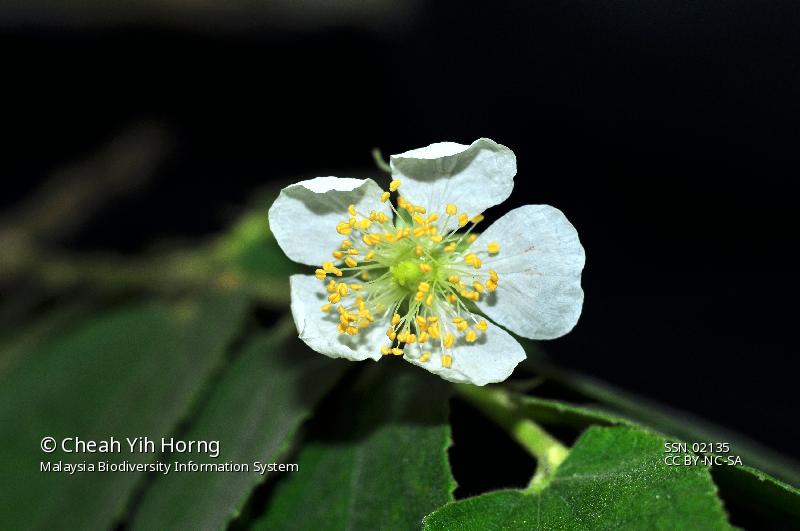
The easiest way to recognise the ‘buah ceri’ tree would be by its drooping branches and spreading crown, resembling an umbrella. Look closer and you will see that its twigs and leaves are densely covered with stellate hairs as well as viscid glandular hairs that are sticky to the touch. The occurrence of 1–2 prophylls (hair-like appendages) in between a tuft of white hairs at the leaf node is another interesting feature of this species. Other spot-characters include the asymmetrical leaf with an unequal base, the sweet-scented white flowers with erect stalk, and the pendent, glossy maroon fruit that looks like a cherry when ripe; hence being dubbed ‘buah ceri’ locally.
The ability of this species to thrive on poor soils and withstand drought has had an impact on its distributional pattern. This fast-growing species which originated from tropical America was introduced to the Old World, first to the Philippine Islands in the late 19th century, then to Thailand and subsequently spreading throughout Peninsular Malaysia and Borneo. It is commonly seen growing in disturbed lowland areas, by roadsides, and in old tin tailings. Its ruderal characteristics allow it to inhabit early successional habitats. It is not found in forests.
Formerly, M. calabura was placed in families such as Elaeocarpaceae and Tiliaceae but based on morphology and molecular data, Bayer et al. (1998) proposed a new family, Muntingiaceae that includes Muntingia, Dicraspidia and Neotessmannia. The distinct characters possessed by members of this new family are the co-occurrence of stellate and glandular hairs, flower insertion at the supra-axillary position, and dimorphism of prophylls. Its closest relative in Malaysia is the Thymelaeaceae.
Muntingia calabura was once popular locally as a shade tree but later became unwelcome because of the unsightly pink splashes of its seeds which are dropped by bats and birds. It flowers and fruits continuously throughout the year. Birds, bats, squirrels, monkeys, and even children, hunt for its edible, sweet and juicy fruits. The flowering pattern of M. calabura is quite fascinating. The first flower in a cluster to open has a well-developed pistil and fewer stamens, to ensure fruit formation through pollination. The subsequent flowers that open have smaller pistils and more stamens, presumably to act as pollen donors. However, if a pollinator is not available, self-pollination takes place (Bawa & Webb, 1983). This species attracts flying pollinators, mostly bees, by displaying its flowers above the branches, and facilitates dispersers such as bats that cling underneath branches, by lowering its fruits below the branches. Interestingly, a single mature fruit that measures about 1.5 cm in diameter can contain up to a whopping 5000 seeds (Bawa & Webb, 1983). Because its fruits are attractive to fruit-bats, Singaravelan & Marimuthu (2006) proposed that M. calabura be grown in and around orchards to lessen bat damage to fruit trees.
